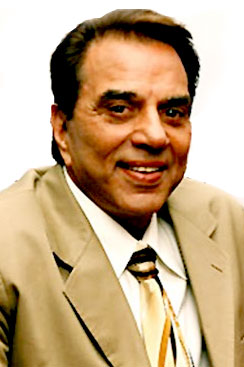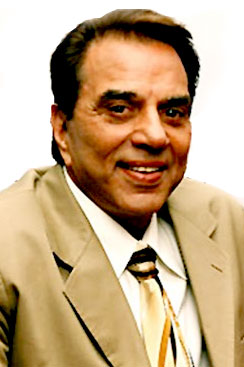Dharmendra
Biography
Dharmendra remained a top Hindi film star for three decades creating an influential image as a markedly North Indian (Punjabi) macho man devoted to his mother and committed to upholding the honour of his family or the village.He was born Dharam Singh Deol in Phagwara, Punjab and was fascinated with films right from childhood, often travelling miles to frequent the touring cinema. (He remembers going to see Dillagi (1949) starring Suraiya at least 40 times!). He was married at the age of 19 and took up a job with an American Drilling Company boring tubewells. Fortunately for him, he was noticed in a Filmfare spot-the-talent contest and came to Bombay to become an actor. He was signed by Arjun Hingorani for Dil Bhi Tera, Hum Bhi Tere (1960), his first film as hero for Rs 51 as signing amount and a daily breakfast that was to contain strictly of tea, two toasts and butter but no jam! Ironically, after all the struggle he went unrecognized at the premiere of the film and sneaked back home on a train.
However strong, supporting romantic lead roles in women oriented films like Anpadh (1962) with Mala Sinha, Bandini (1963) and Soorat Aur Seerat (1963), both with Nutan brought Dharmendra to the fore. A liaison with Meena Kumari saw the two of them starring together in a series of films.
Phool Aur Patthar (1966) finally made Dharmendra into a star. As the ruffian Shaka, Dharmendra combined muscles and sensitivity to give Shaka a human touch. And when he whipped off his shirt in the film, for the first time Hindi filmmakers woke up to the need to cater to female sexuality. In one of the most sensuous scenes in Hindi films, Dharmendra leans over a sleeping Meena Kumari only to finally cover her up.
Most of Dharmendra's earlier films were soft romantic films, many of which presented a secularized Hindustani version of Bengali literary stereotypes, starting with Bimal Roy's Bandini and continuing with Hrishikesh Mukherjee's 60s socials - Anupama (1966), Manjhli Didi (1967) and Satyakam (1969). He mainly played the nice, romantic, handsome hero and was in fact voted as one of the five most good-looking men in the world in the 1960s.
Satyakam saw Dharmendra giving perhaps his greatest ever performance as an idealist seeing his dreams crumble after Indian Independence. It was a sensitive, nuanced performance of an honest, committed man who perseveres with his philosophy of total truth even when it brings about his downfall and one that was straight from the heart. The scene in which he is dying where he just had to emote with his eyes as his estranged father berates him, represent some of the the finest moments in Dharmendra's acting career.
The 1970s saw Dharmendra take to the action genre like a fish to water. (The seeds of this were seen earlier in films like Aankhein (1968), a James Bond style thriller following the success of Phool Aur Patthar) He was prefect as the pistol packing hero threatening the villain - No one could tell the villain, "Kaminey, Main Tera Khoon Pee Jaoonga!" more convincingly than 'Garam Dharam!' Films like Mera Gaon Mera Desh (1971), Jugnu (1973), Kahani Kismet Ki (1973), Yaadon ki Baraat (1973) and Sholay (1975) swept the box-office largely due to Dharmendra's brawn show!
Sholay (1975) and Chupke Chupke (1975) revealed another facet of Dharmendra - his flair for comedy. Even though the former was a large scale action drama, Dharmendra's comic scenes with Hema Malini - feeling her up on the pretext of teaching her how to fire a gun or speaking to her as the 'voice of God' or of course his 'soo-cide' scene with her aunt, him atop a water tank and threatening to jump if she didn't marry her niece to him - were among the many highlights of the film. And Chupke Chupke saw him single-handedly carry Hrishida's whacky comedy of a botany professor who impersonates a driver to spend some precious time with his wife at her brother-in-law's place! It is a masterful performance with razor sharp comic timing.
Dharmendra also formed a hugely successful pairing with Hema Malini, the two of them doing a string of hit films together - Naya Zamana (1971), Raja Jani (1972), Seeta Aur Geeta (1972), Jugnu, Dost (1974) and Sholay among others. They fell in love and Hema became his second wife. Dharmendra and Hema went on to have children as well but so strong was her morally upright image that she was able to go through the marriage without being slandered by press or public which in fact more than accepted the union.
The 'Garam Dharam' act was perfected in the 1980s by Hindi filmmakers as Dharmendra was cast as the invincible hero bearing colloquial names like Veeru Dada, Hathoda Singh or Sherdil who was locked in mortal combat with the villain. But his films were largely undistinguished and of poor quality even if a couple did score at the box-office. (Aag hi Aag (1987), Hukumat (1987))
In fact, among Dharmendra's later films in the 1980s and 90s, his work with director J.P. Dutta stands out - Ghulami (1985), Yateem (1988), Batwara (1989), Hathyar (1989) and Kshatriya(1992). The films barring Hathyar were mainly set in feudal Rajasthan featuring conflicts among the Jats and the Thakur Zamindars with Dharmendra usually playing a powerful charismatic leader who unites the people against the oppressive thakurs.
Dharmendra has successfully launched both his sons Sunny (Betaab (1983)) and Bobby (Barsaat (1995)) as leading men and today his daughter from Hema Malini, Esha Deol, is on the verge of becoming a successfull actress. Though he shockingly won no major awards throughout his entire career, Dharmendra was awarded the Filmfare Life Achievement Award for his contribution to Indian Cinema.
Details
Sign
Sagittarius
Birth Date
8 December 1935
Birth Place
Sahniwal, Punjab
First Movie
Dil Bhi Tera, Hum Bhi Tere-1960
Height
5' 8



















